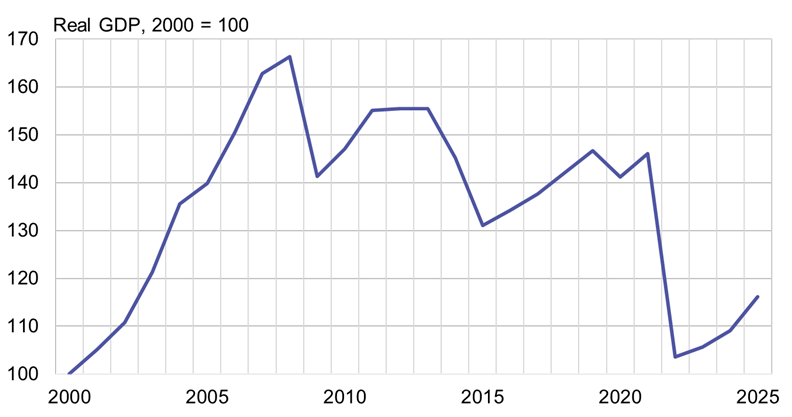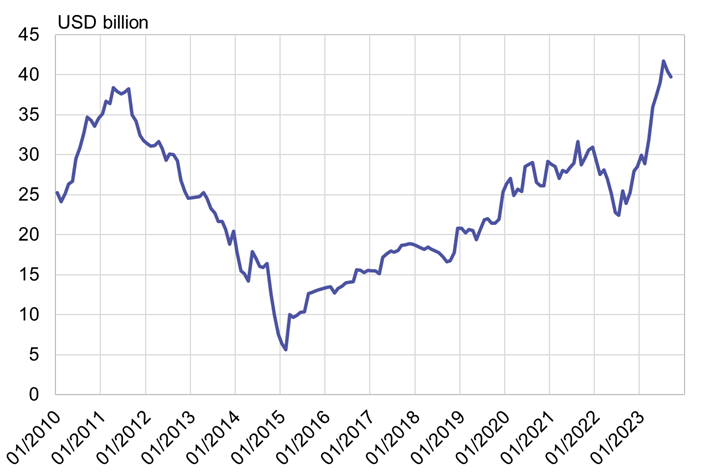BOFIT Weekly Review 41/2023
Ukraine’s economy returns to growth, but recovery from war’s destruction takes time
Ukraine’s GDP contracted by 29 % last year due to Russia’s illegal war of aggression. Economic activity declined most in the first half of 2022 after Russia occupied large areas in eastern and southern Ukraine. Millions of Ukrainians were forced to leave their homes and move to western Ukraine or abroad. Russian acts of war have destroyed a substantial part of Ukraine’s economic capacity. The partial or complete disruption of maritime shipping in the Black Sea has significantly affected Ukrainian exports. Before the February 2022 invasion, about 90 % of Ukraine’s food exports were shipped via Black Sea ports. In 2021, foodstuffs represented about 40 % of Ukraine’s total exports.
The contraction of economic activity last year was quite broad-based. The sectors with highest growth this year have been retail & wholesale, as well as transport. Some of this growth reflects the return of people who fled the country last year. Significant portion of people who left the country in 2022 have returned. Economic activity in many regions in western Ukraine had recovered to pre-invasion levels by the end of last year. Russia’s attacks on Ukraine’s energy infrastructure last winter affected economic performance throughout the country.
Growth in Ukrainian GDP has resumed, but still has a long way to go to make up for production lost during the war

Sources: IMF, BOFIT.
Ukraine’s economy returned to positive growth late last year, but that growth starts from a very low level. The International Monetary Fund (IMF) forecast released this week sees Ukrainian GDP growing by 2 % this year, while the European Bank for Reconstruction and Development (EBRD) expects GDP growth of 1 % this year. The average of forecasts collected by the Consensus Economics research institute was 2.7 % for 2023 as of September. The GDP forecast released in August by the National Bank of Ukraine (NBU), predicted growth of 2.9 % this year. The upcoming NBU October forecast is expected to foresee even higher growth this year.
Virtually all major institutional forecasters expect Ukraine’s economic recovery to accelerate next year. The IMF forecast for 2024 sees GDP growth of 3.2 %, the EBRD 3 %, the NBU 3.5 %, and the average of major forecasts compiled by Consensus Economics 5.2 %. All forecasts are subject to tremendous uncertainty stemming from the future course of war and commitment of Ukraine’s economic supporters.
A significant share of Ukraine’s economic activity and the current counteroffensive has been supported by economic assistance in the form of donations or loans. Under the IMF’s four-year Extended Fund Facility (EFF) programme, Ukraine is permitted to borrow up to 15.6 billion dollars. The EFF was approved in March, and Ukraine has currently drawn about 3.6 billion dollars (3.4 billion euros) of its allocation. The EFF includes guidance on macroeconomic policy as well as recommendations on structural reforms to the Ukrainian economy.
Ukraine’s biggest financial supporter this year has been the EU. Under the EU’s Macro-Financial Assistance Programme, Ukraine has received 12 billion euros in loans. Aid from individual countries has also been important for Ukraine. Data compiled by the Kiel Institute for World Economics show the total amount of promised and delivered financial assistance from EU institutions since January 2022 amounted to 77 billion euros. The United States is Ukraine’s biggest supporter in terms of military aid.
Ukraine’s central bank last year covered the bulk of the public sector deficit, but this year the situation has changed dramatically. For the first nine months of this year, Ukraine’s fiscal deficit amounted to roughly 32 billion dollars. Nearly all of the deficit was covered with international financing, of which about a third came in the form of donations. The easing of Ukraine’s financial struggles has given the NBU an opportunity to relax e.g. capital controls. As of end-September, the central bank’s gold and currency reserves amounted to about 40 billion dollars. With Ukraine’s foreign currency reserves at their highest level since 2011, Ukrainian financial markets have stabilised somewhat.
Ukraine’s foreign currency reserves have grown considerably since mid-2022

Sources: National Bank of Ukraine and BOFIT.